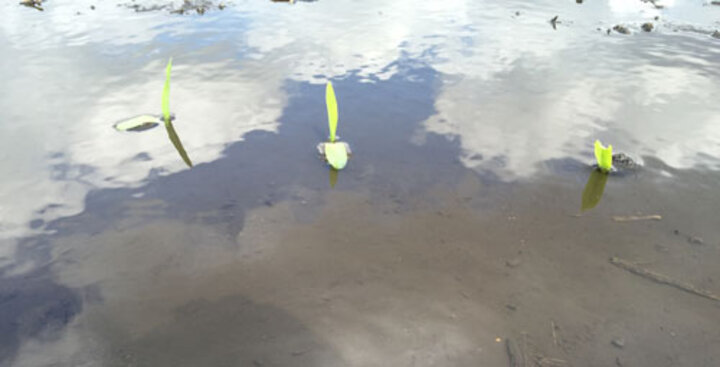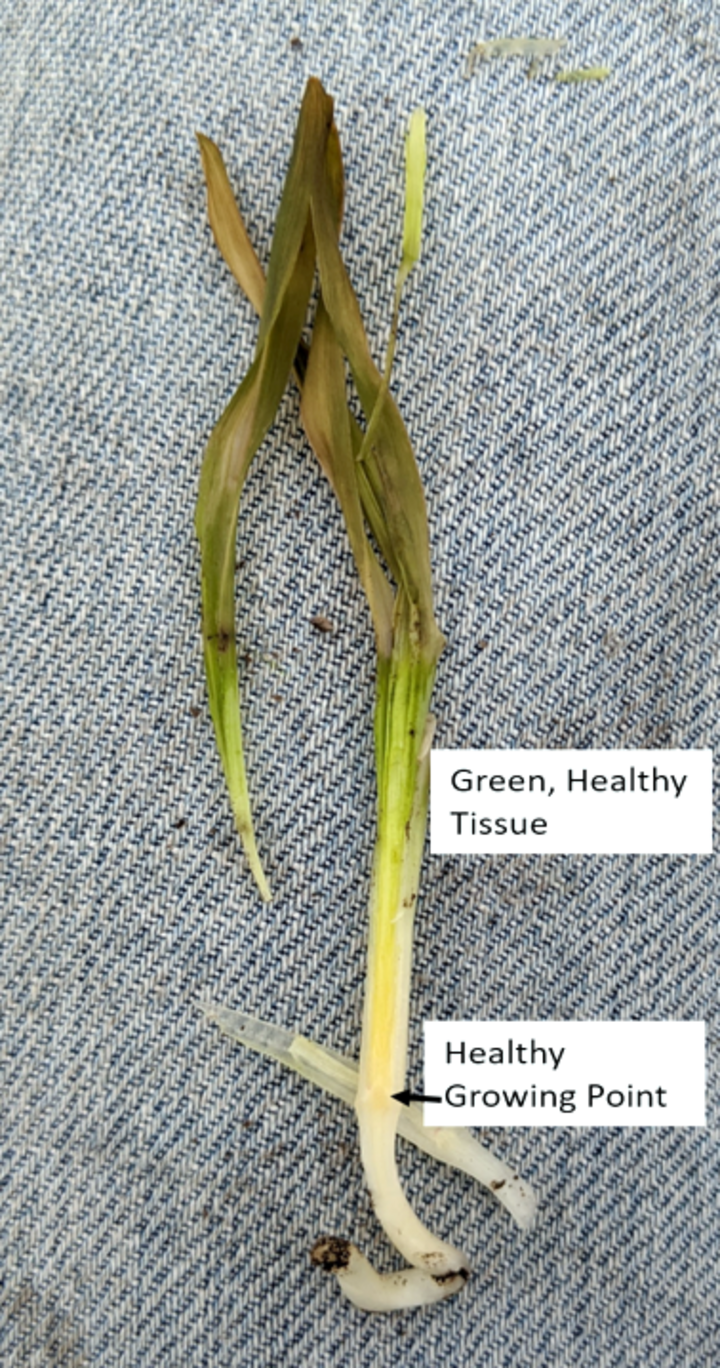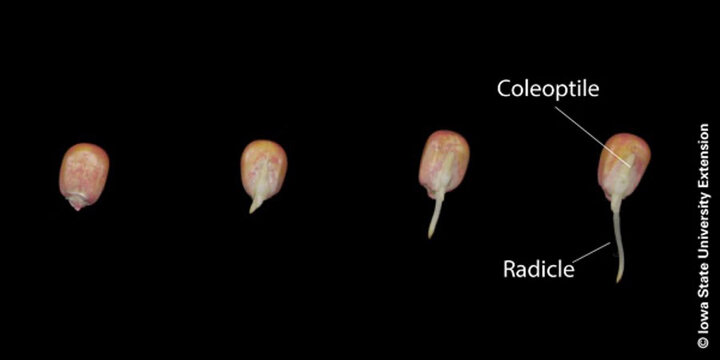Key Points
- Cool air temperatures will help increase the possibility of survival, but germinating corn seed and plants would not be expected to survive more than four days in flooded and saturated soils.
- Corn from emergence to V6 can live four days under water if air temperatures are lower than the high 70s. Seedlings may survive one day when air temperatures are greater than that.
- A two-day flooding event after soybean seed imbibition and swelling can reduce germination by 20%-43%.
- Soybean in vegetative stages usually has less injury from saturated soils than in the reproductive and grain filling stages. Main impacts include stand loss, reduced plant branching, shorter plants and reduced pod number.
In this Market Journal segment from 2015, Nebraska Extension Educator Nathan Mueller discusses how saturated and flooded soils may affect early corn and soybean seedling development and disease.
Heavy rains of 5+ inches May 20-21 in eastern Nebraska resulted in standing water (flooding and ponding) and waterlogged/saturated soils of some fields. Many farmers pushed hard with planting prior to these rains. What should growers expect regarding any impacts to seed germination through early development of corn and soybean?
Germinating and Emerged Corn
Table 1 summarizes research information on this question for corn. Smaller seedlings are more susceptible than larger seedlings. Unfortunately, the effect of standing water on germinating seeds is not well known; some hybrids may respond better than others, but limited data exists. Germinating seeds are living organisms and require oxygen to survive. The oxygen supply in flooded or saturated soils will become depleted within about 48 hours. Cool air temperatures will help increase the possibility of survival, but germinating seed and plants would not be expected to survive more than four days. Residue washed over germinated seed and plants can also create a problem with survivability.

Saturated soils can impact corn yields in the germination through V6 stage by: reducing plant and ear height, leaf area, dry matter accumulation, root length; death of plants; shortened anthesis-silking interval; reduced N,P, K, Zn concentrations in leaves; ears per plant and grain weight per ear; and reduced greenness and stomatal conductance (Kaur, et. al, 2019).
Seedlings with fewer than six leaves can withstand four days under water if air temperatures are lower than the high 70s. If air temperatures are greater than that, seedlings may only survive one day. Emerged Nebraska corn has fewer than six leaves at this time. Corn not completely submerged has some limited capacity for diffusion of oxygen from the shoot to the root that can increase survival.
Potential yield losses based on a recent literature review by Kaur, et. al, 2019:
- Four weeks after planting: Waterlogged duration of one to six days: 6-61% yield loss
- V3: Waterlogged duration of seven days: 16-38% yield loss
- V6: Waterlogged duration of 1-7 days: 10-36% yield loss. Waterlogged duration of 3-12 days: 27-56% yield loss.
| Table 1. Survival of flooded young corn plants. Adapted from CropWatch, May 20, 2005. | ||
| Stage | Condition | Potential for Survival and Problems |
| Before emergence | Germinating | Genetic differences among inbreds (and we assume hybrids) exist for responses to flooding. Seeds will survive for four days. Longer flooding results in lower yields especially at lower nitrogen levels. Crusted soils from heavy rains can reduce emergence. |
| Corn prior to 6th leaf stage | Underwater (6 inches of water on surface); air temperature less than 77°F | Will survive for four days. Longer flooding results in lower yields especially at lower nitrogen levels. Some plants will be buried by sediment and residue and may not survive. |
| Corn prior to 6th leaf stage | Underwater (6 inches of water on surface); air temperature greater than 77°F. | May not survive more than 24 hours. |
| Corn prior to 6th leaf stage | Saturated, cold soils, flooding | Seed rots, seedling blights, various other pathogens, crazy top |
Assessing Survival
After soils dry and waters go down, confirm plant survival by examining the color of the growing point of the seedlings (Figure 2). The growing point should appear cream colored and firm, not brown and soft. For germinating seeds, the radicle (root) and coleoptile (shoot) should appear white or cream-colored (Figure 3). Surviving plants should resume growth within three to five days after the water recedes.

As fields drain and soils dry, assess surviving plant populations and — if stands are weak — consider the economics of replanting corn or planting another crop. Please see this article on Replant Considerations for Corn.
Additional points on heavy rains, flooding and crusting. (From CropWatch, May 23, 2011)
- The longer an area remains ponded, the higher the risk of plant death.
- Even if surface water subsides quickly, the likelihood of dense surface crusts forming as the soil dries increases the risk of emergence failure for recently planted crops.
- Extended periods of saturated soils after the surface water subsides will take their toll on the overall vigor of the crop.
- Watch for diseases or other problems as the season progresses.
- Associated with the direct stress of saturated soils on a corn crop, flooding and ponding can cause significant losses of soil nitrogen due to denitrification and leaching of nitrate N. “Corn waterlogged at the V4-V5 growth stage for 3-4 days reduced yield in Ohio trials by 25-45% when 100-120 lb N were applied pre-plant and no additional nitrogen was applied compared to non-flooded plots. On the plots that had pre-plant N applied, adding 60-120 lb N post-flooding resulted in yield losses of only 3-15% compared to non-flooded controls receiving the same N application regime.” (Lindsey, et. al, 2022).
Germinated and Emerged Soybeans
We know that prolonged flooding affects plant growth as a result of inadequate oxygen to sustain root respiration and growth. Excessive water also is detrimental to soybean nodulation formation and function. The amount of injury depends on variety, growth stage, duration of waterlogging, soil texture, fertility levels and diseases present; but it is clear that the longer soil is saturated, the greater the impact on growth and yield.
Germinated Seed
What are the impacts of flooding on germinating seed? Unfortunately, few research reports discuss the impact of flooding on germinating seeds and emerging seedlings. Wuebker et al., 2001, discussed and investigated early-season soaking effects on seeds and seedlings. Their growth chamber study showed that the timing of flooding relative to the days after imbibition affected germination. They found:

- Soaking seed beginning one day after imbibition reduced germination by more than 20%, but there was little difference in germination among soaking times (ranging from one to 48 hours).
- When soaking began two or three days after imbibition, germination was reduced — by 50% to 70%, respectively — with 48 hours of soaking. Soaking seed for one to 24 hours beginning two to three days after imbibition reduced germination by 25% to 33%, respectively.
- Other sources cited by Wuebker et al. stated that most soybean varieties subjected to four days of soaking prior to germination had severe germination losses; thus, varieties may differ in their responses to flooding.
- Temperature also affected responses. Seed soaked from one to 48 hours at 59ᴏF reduced germination by an average 39% less than the control. Germination was similar no matter how long the seed was soaked. However, when seed soaked for 48 hours at 77ᴏF, germination fell over 60%; when seed soaked for one to 24 hours at 77ᴏF, germination averaged 27% less than the control. Cooler temperatures improve soybean viability.
Early-Vegetative Development Stages
Impacts of flooding during early-vegetative development stages of soybean are better documented, as noted in an earlier CropWatch article based on a KSU news release:
"Vegetative growth stages. Excess water during vegetative stages usually causes less injury than waterlogging during the reproductive and grain filling stages. Short-term waterlogging (two to three days) at the V2 to V4 stages can cause yield reductions of 0 to 50%, depending on soil texture, variety, and subsequent weather. Yield reductions from waterlogging during the early vegetative stages have been attributed to reduced plant population and shorter plants with reduced branching and fewer pods per plant. As the duration of soil saturation increases, researchers have documented greater reductions in population, height, pods per plant, yield, and leaf tissue nitrogen… "
Other scientists compared soybeans subjected to waterlogging for seven days at development stages ranging between V2 and R 6.3 in a growth chamber (Linkemer et al., 1998). The most sensitive stages in terms of yield reductions were V2, R1, R3, and R5. Yield losses at V2 were 29% below the control.
For replant considerations, please see the article Soybean Replant Considerations.
References
Dill, T.E., S.K. Harrison, S.W. Culman, and A.J. Lindsey. 2020. Grain yield response of corn (Zea mays L.) to nitrogen management practices and flooding. Plants 9:348.
Elmore, Roger. May 13, 2014. Flooding and Corn Survival. https://cropwatch.unl.edu/flooding-and-corn-survival
Elmore, Roger and Jim Specht. May 13, 2014. Early-Season Flooding and Soybean Survival. https://cropwatch.unl.edu/early-season-flooding-and-soybean-survival
Kaur, Gurpreet, Gurbir Singh, Peter P. Motavalli, Kelly A. Nelson, John M. Orlowski, Bobby R. Golden. December 2019. Impacts and management strategies for crop production in waterlogged or flooded soils: A review. https://doi.org/10.1002/agj2.20093
Lindsey, Alexander, Mark Sulc, Laura Lindsey, Osler Ortez, Peter Thomison. June 15, 2022. Growth stage has major impact on crop survival in flooded conditions. https://agcrops.osu.edu/newsletter/corn-newsletter/2022-18/crops-under-water-%E2%80%93-crop-stage-critical-recovery
Wuebker, Eileen Feilmeier, Russell E. Mullen, and Kenneth Koehler. 2001. Flooding and Temperature Effects on Soybean Germination. https://doi.org/10.2135/cropsci2001.1857
